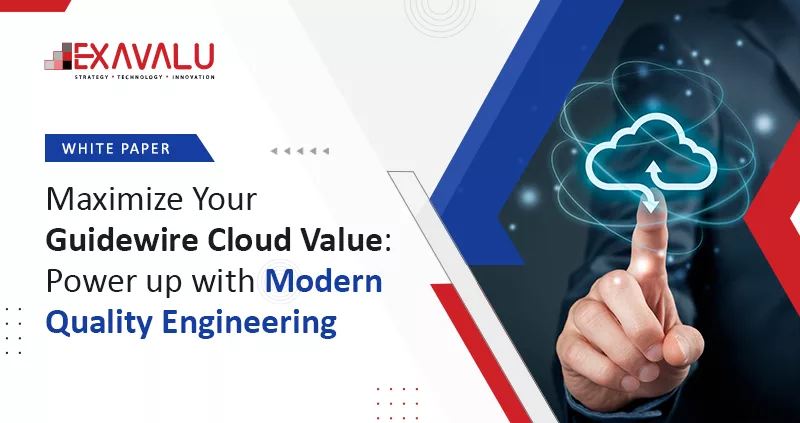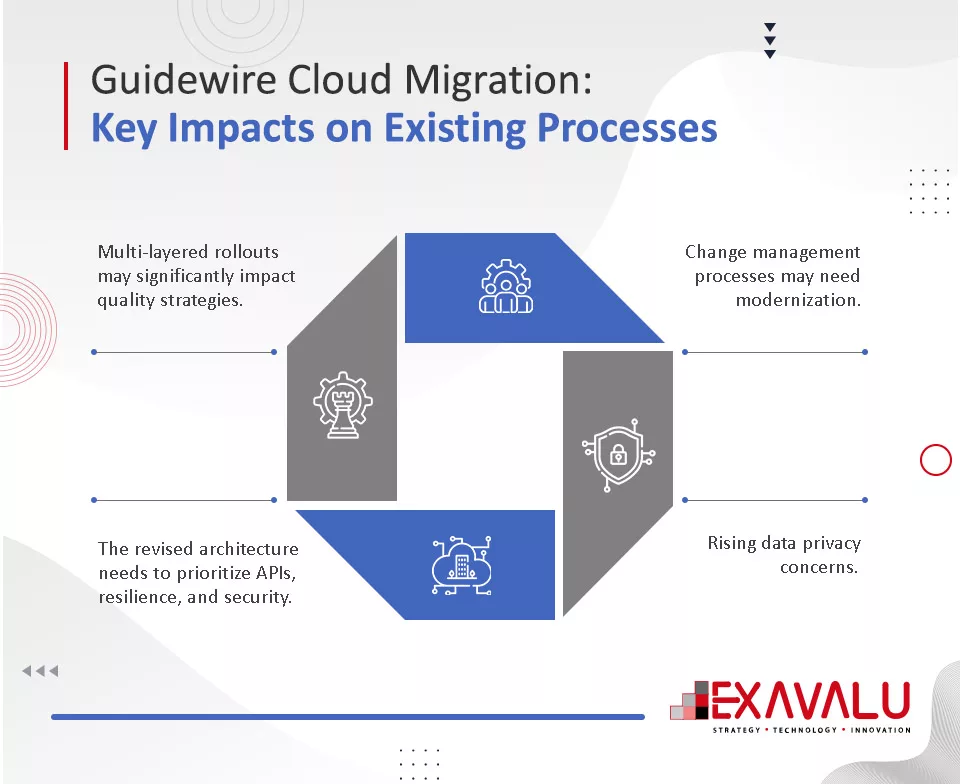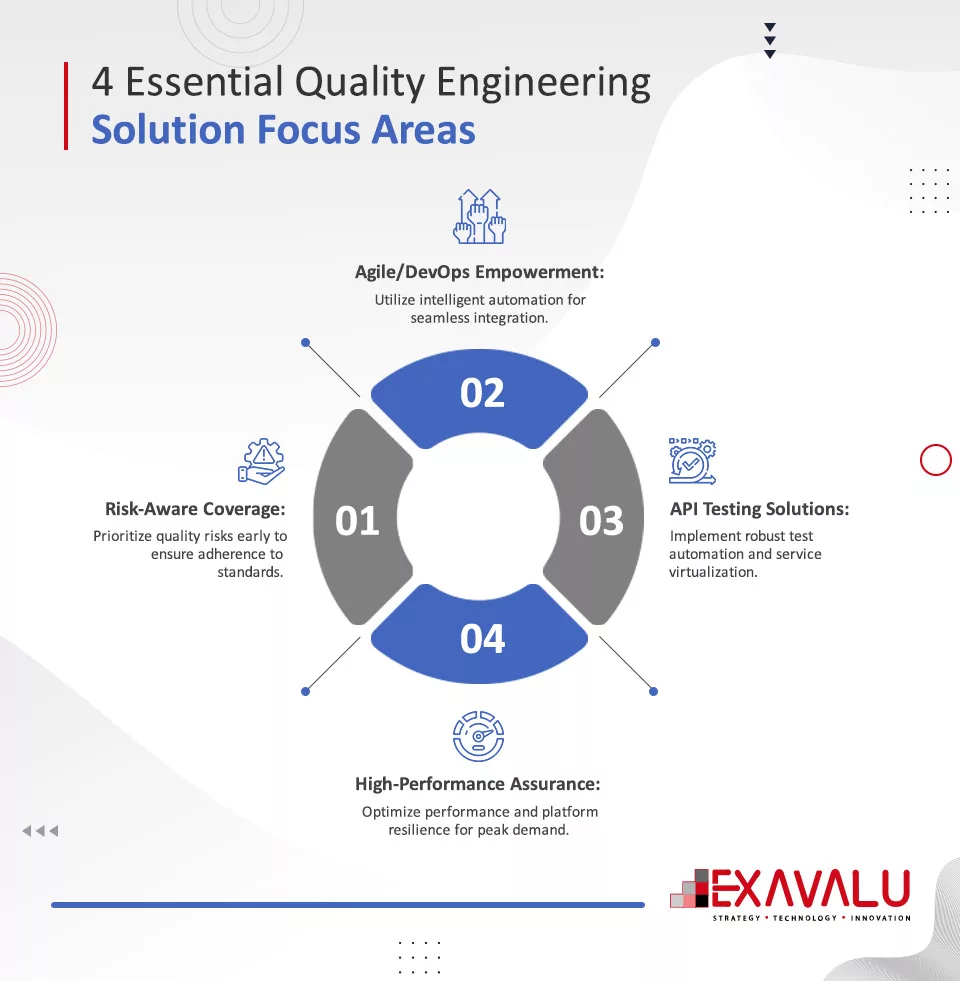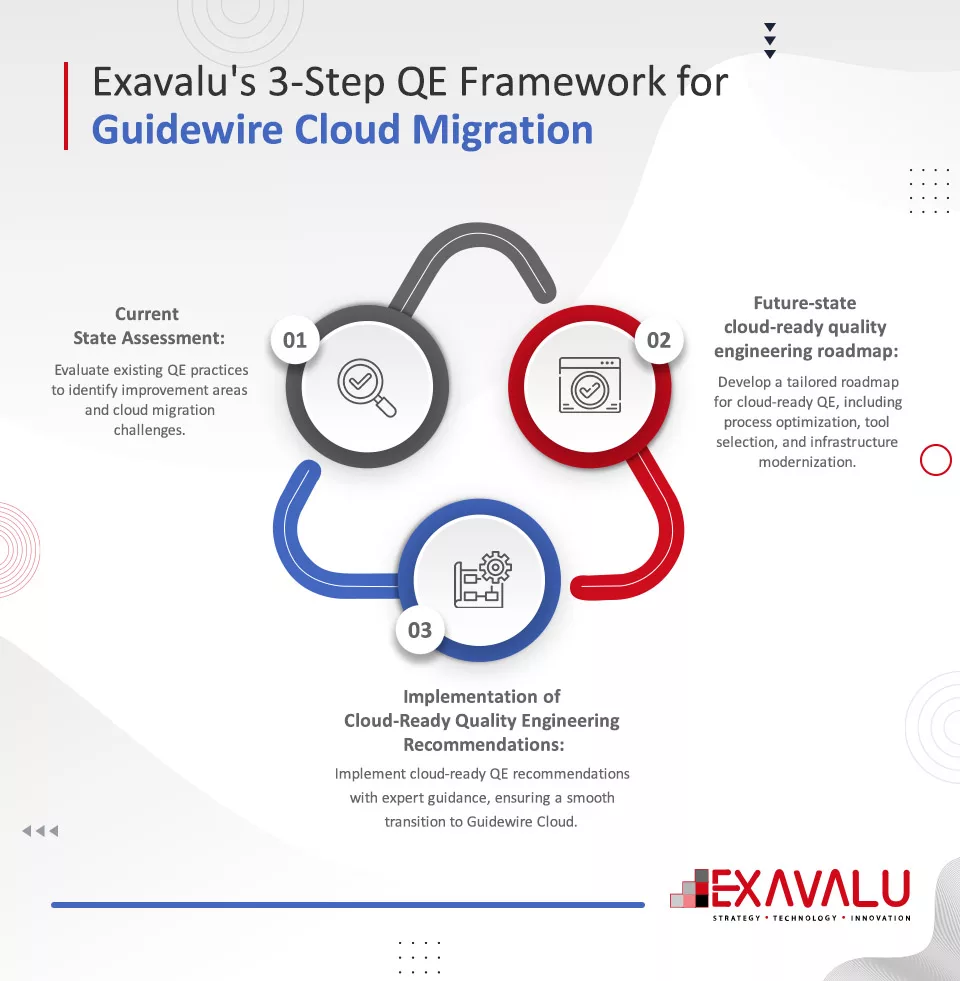
Modernize your Quality Engineering Capabilities to Ensure the Right Value of Your Guidewire Cloud Migration
Executive Summary:
Cloud has brought about a seismic shift in the way modern businesses are operating. With the move from on-premises to Cloud architecture, businesses are hoping to gain the promised benefits from their cloud software vendor’s most recent digital innovations through frequent software upgrades.
Within the P&C Insurance industry, carriers who have invested in Guidewire core modernization are making a strategic transition to Guidewire cloud, some through a lift-and-shift approach to transition urgently, while others are taking thoughtful steps to first remove technical debt and retrofit their self-managed customization, before migrating to Guidewire Cloud. In both cases, the journey comes with its unique challenges because running a core insurance system in the cloud challenges the traditional operating model for IT application management. Carriers who are embarking on this strategic initiative, must radically transform their application life cycle management to accommodate a modern, frequently changing SaaS software in a highly regulated industry as Insurance.
Additionally, the reliance on a multitude of other eco-system software partners that integrate with Guidewire necessitate efficient ways of test coverage and planning, test case management, and test automation along with additional challenges for monitoring, performance management and information security assurance.
Migrating a core insurance platform to cloud requires a modern Quality Engineering philosophy and multiple tools and frameworks that enable the carrier to efficiently gain value from the SaaS software through advanced DevSecOps capabilities.
This Exavalu white paper offers a well-defined three-step framework that P&C carriers can follow to ensure that a migration to cloud realizes the best possible outcomes by recommending a transformation of traditional Quality Assurance practices.
Our pioneering framework includes a detailed gap analysis of current-state quality management processes, a practical and impactful future-state quality engineering roadmap, and a partnership model to support carriers implement practical steps and ensure a Cloud-proof Guidewire Quality Engineering solution framework. This framework can also be leveraged by P&C carriers who are already on Guidewire Cloud, for making their Quality assurance approach more robust and aligning with the demands of a Cloud/SaaS environment.
1. Guidewire Cloud Readiness is a complex transformation that goes well beyond the core
The journey to Guidewire Cloud is not just a technological transition; it needs fundamental rethinking of IT application management and product development. This causes significant demands made on existing SDLC processes and operating norms. Some of these challenges are:

a. Multi-layered rollouts deeply impact Quality strategies
The P&C Insurance industry is going through some significant churn. Climate hazards, rate pressure, talent scarcity are negatively impacting growth and combined ratios for the carriers. Carriers need to become more innovative in their use of advanced technologies and InsurTech solutions, while respecting the cross functional processes that make them successful. This makes an already-complex process even more complex. Market penetration implies more state rollouts. IT modernization means complex data conversion initiatives. Additionally, the need to improve products and rates necessitates a complete pricing refresh. More frequent product launches require added rate management agility and process improvements. Software testing and User Acceptance Testing strategies will therefore need to ensure effectiveness and efficiency at the same time through advanced frameworks and modern test automation tools. Leveraging value from more frequent upgrades requires being prepared to test, accept, and roll out new features more quickly without drastically increasing the cost of quality, compromising product quality, or causing compliance issues.
The automation approach therefore must follow a dual-shift philosophy; a Shift-Left mindset to involve developers early in the process through Test Driven Development (TDD) practice, while Shift-Right model enables collaboration with Business teams by involving them in the Business-Driven Development (BDD) framework. A highly effective and modernized quality engineering capability for Guidewire cloud involves complementing Guidewire’s GT framework with additional open-source QA Automation frameworks for maximum effectiveness.
b. Modernizing the Change Management Processes
While Guidewire Cloud offers a great platform for operational scale and access to innovations, the new operating model requires a rethinking of the existing change management processes. More frequent upgrades and lack of complete visibility to areas of software change will put undue pressure on the quality assurance teams, therefore they will need to adapt by modernizing and accelerating their ability to accept changes while avoiding software risks.
c. Revised Architecture needs focus on APIs, resilience, and security
Migration to the cloud will fundamentally alter the application architecture of the carriers over time. The need for open and composable architecture necessitates the removal of monolithic, point to point integrations and legacy data integrations. APIs change the way information is exchanged between applications that will operate in a hybrid cloud environment. The number of integration points, therefore changes exponentially and the inability to architect a cloud-ready integration framework will adversely impact the cost of ownership. Solutions such as microservice virtualization, API management tools and a higher degree of operational resilience requires a modern API management framework that forces a refactoring of legacy integrations to allow for improved scalability, manageability, security and monitoring of real time, mission-critical integrations.
d. Data Privacy
With the Cloud comes great power. With great power comes greater responsibility for the IT custodians, particularly in a heavily regulated financial industry. Thus, carriers need to think about how to build zero-trust security as an ongoing discipline that guards the movement, storage and transfer of sensitive information. While cloud security assurance becomes mandatory when the carrier is no longer the true custodian of the sensitive policy and claims data, ensuring security and compliance of the SaaS software requires strengthening the principles of Data Protection and Management once carrier data moves to Guidewire Cloud.
e. Modernizing CI/CD to reengineer Release Management
Carriers are striving to turbo-charge their product development speed and pricing flexibility to remain competitive. Operating your most mission-critical software in the cloud requires a consistent culture of continuous deployment to empower the business to operate with speed while remaining compliant. Continuous deployment, not just for Guidewire, but also for all the surrounding subsystems, needs to be enabled through continuous integration some of which is managed by Guidewire and some that are managed by the carrier’s internal teams. A robust Quality Engineering framework is needed to ensure maximum test automation, ensuring a smooth transition to new integrated releases through DevOps model.
2. Quality Engineering for Guidewire Cloud can no longer be supported the old way
P&C carriers have a promising business growth potential to be realized by their strategic move to Guidewire Cloud. They will need to be attentive to the challenges that such a change is accompanied by. It is imperative for them to recognize the need of a robust and thoughtful Quality Engineering strategy to address these challenges in a proactive manner, because Quality needs to be at the core of any customer-centric philosophy.
Addressing the Quality effectiveness and efficiency needs for P&C products and services on Guidewire Cloud is a complex problem statement, that calls for process and tools modernization as well as an equipped workforce. To address the challenges, the Quality Engineering solution approach needs to address four key areas:

a. Risk-sensitized coverage
Carriers cannot test too little, and they cannot test too much. They must balance the cost of quality with the highest quality assured for each release. Business stakeholders need to be assured that the test coverage has addressed all the key functionalities across the breadth of impacted business areas. Also, with state rollouts being a critical part of the business growth strategy, the regression framework on Guidewire has to follow a trunk-and-branch test case management approach, which espouses the creation of a core repository for the parent/core state(s) and branch repositories to align with the subsequent states for the products being rolled out. The test design approach also must lend itself to the ability to do intelligent test management, which is all about choosing the right set of test cases to be executed in alignment with the scope of a particular release.
b. Agile/DevOps enablement through Intelligent and Inclusive Automation
The Automation strategy under the broader Quality Engineering philosophy for Guidewire Cloud must completely enable the Agile model of rolling out products. Quality Engineers positioned within Product Pods have to function as Software Development Engineers in Test (SDETs), who can influence the Automation strategy and design, can work on Automation scripts while the user stories are being developed, can bring the power of predictive analytics to the Quality approach, and really play the championing role when it comes to rolling out high-quality products. They must push for maximum automation in regression to drive a completely automated pipeline which will underpin the culture of Continuous Deployment on Guidewire Cloud.
c. Test Automation solutions and Service Virtualization for API Testing
Thus, to effectively test Guidewire services and third-party integration with data providers, a robust quality engineering capability is required to conduct API testing in a cost-effective manner. Service virtualization and data virtualization solutions must be added to the quality engineering toolset to effectively test Guidewire interfaces.
d. Assurance of High-Performance and platform Resilience
Moving to Guidewire Cloud, while thousands of remote employees and hybrid web services access Guidewire, requires a robust and high-performing system that is constantly monitored by the carrier in a trust-but-verify operating model. Regular non-intrusive and integrated stress testing, and the necessary load testing after each release, is required at a cost-effective and efficient manner that ensures service resilience. This can only be ensured if carriers think of performance as a core platform feature, and not as a non-functional requirement. Performance Engineering mindset is a mandatory requirement and product owners need to think about building end-to-end performance into the core platform. The other key aspect to consider is to ensure the security of the data in the cloud platform.
With a multitude of threat actors on the rise, security must be built into carrier’s DevOps model, thereby mandating the culture of DevSecOps. A modern approach to Quality Engineering using an integrated people, process and technology modernization requires a constantly evolving competency addressing these critical aspects as well.
3. Envision and implement Cloud-Ready Quality Engineering through a 3-step Assessment-Implementation framework
Given the complex set of challenges to address , when operating a sophisticated digital insurance core platform in the cloud, carriers need to commit to become cloud-ready across the carrier’s entire SDLC spectrum. Carriers must apply a systematic approach to understanding the past SDLC practices, analyze the present gaps, bottlenecks, as well as tool and process inefficiencies, and move rapidly to a cloud-ready operating model for quality engineering and assurance in ways that embrace the modern Guidewire software lifecycle.
Exavalu offers a systematic, 3-tiered, approach to help carriers make the most of their investment in Guidewire Cloud with the intent to increase innovation and business agility.

Step 1: Current-State Assessment
As the first step of the framework, a team of Guidewire QE experts will do a detailed fact-gathering of Quality assurance processes currently followed on the Guidewire Cloud instance for all the 3 Guidewire Centers. The focus will be both broad and deep and will cover as-is tools/framework usage including GT and any other solutions, regression coverage from the perspective of business functionalities as well as automation %, existing approach to end-to-end automation, and current framework’s ability to ensure performance engineering and security assurance requirements. There will also be reviews of the current workforce’s readiness to drive Quality Engineering on Guidewire Cloud, and the efficacy of the Metrics to drive business outcomes.
This phase of the assessment will help carriers understand, through an impactful report, where they currently stand with respect to a best-in-class Quality Engineering solution framework for deriving the maximum benefit of Guidewire Cloud eco-system. The report will assess carrier’s quality of test design, the presence (or lack of) of an Automation-First philosophy, the degree of collaboration between Development, QA and Business, and current tools and technologies.
Step 2: Future-State Cloud-Ready Quality Engineering Roadmap
With a clear picture of the current state thus established, the Exavalu team will move to the second step of the process to define a future-proof Quality Engineering operating model for the organization. This future-state Cloud-Ready roadmap will cover:
- Strategy to make Test Automation Intelligent, Inclusive, and Integrated.
- End-to-end Automation strategy enabling the best outcomes to be derived out of GT framework and a complementary set of open-source tools, thereby ensuring effectiveness as well as efficiency.
- Enable and amplify collaboration between Business Product teams and technology teams.
- Actionable recommendations for Performance Engineering and DevSecOps capabilities.
- Plan to move to a Predictive and Proactive Model to build high-quality products.
- Transform workforce from testing competency to Quality Leaders by propagating a SDET mindset, who can fully support a robust Quality Engineering framework for Guidewire in the Cloud.
- Establish the leading and lagging indicators and metrics that are designed to ensure ongoing quality improvements through automation and quality effectiveness.
Step 3: Implementation of Cloud-Ready Quality Engineering Recommendations
Exavalu’s Guidewire Quality Engineering CoE operates based on the philosophy of partnering with carriers in their long-term and transformative journey to Guidewire Cloud. As the third and the final step of the Cloud-Ready Quality Engineering transformation, Exavalu can assist in the enablement of the future-state recommendations in two steps:
- Undertake a Proof of Concept to demonstrate the value of an Automation-First Quality Engineering approach using high-impact automation scripts and modernized testing frameworks and tools.
- Based on the consensus around the outcomes of Step A, Exavalu can implement the full suite of recommendations around Process, Tools, and Workforce.
Exavalu has successfully implemented this framework for a US West-based carrier to achieve over 30% QA cost savings while improving test coverage and accelerating the carrier’s ability to accept frequent Guidewire updates with confidence of the quality before deploying the update to production. Additionally, this framework has enabled carrier CXOs to feel more confident about IT’s ability to maximize the benefits offered by Guidewire Cloud.
Conclusion
A Modern and Cloud-Ready Quality Engineering framework is essential to ensure the promised value from Guidewire Cloud
The Insurance industry is at an inflection point today. Carriers are under significant pressure to accelerate innovation, improve cost efficiency and accelerate business agility. Guidewire Cloud offers cloud-native capabilities to onboard software innovations at a far more rapid pace than carriers have been operating in the past. However, for carriers to fully realize the value of Guidewire Cloud, old SDLC operating models and Quality Assurance practices will significantly impede this value realization. As IT leaders rush to the cloud, on day-two of their Guidewire Cloud operations, a realization that old self-managed software practices will not fit the promise of Guidewire Cloud will set in. This is where a smart Quality Engineering solution framework can really bring in a lot of predictability and reliability, while boosting the product rollout process. The proven 3-step assessment and implementation framework from Exavalu’s Guidewire Quality Engineering COE is designed to ensure that Guidewire customers are able to perform the necessary internal transformation to realize the value of Guidewire Cloud.
About Author
Moulinath Chakrabarty is a client executive partner with Exavalu’s Insurance practice. He has 20+ years of Insurance experience, and specializes in advising Insurance carriers on best practices for driving digital transformations with Insurance core products at the center of such initiatives. You can reach him at Moulinath.Chakrabarty@exavalu.com.
